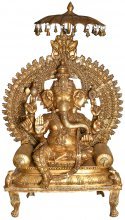Ihaloka, Iha-loka: 14 definitions
Introduction:
Ihaloka means something in Buddhism, Pali, Jainism, Prakrit, Hinduism, Sanskrit, Marathi, Hindi. If you want to know the exact meaning, history, etymology or English translation of this term then check out the descriptions on this page. Add your comment or reference to a book if you want to contribute to this summary article.
Alternative spellings of this word include Ihlok.
Images (photo gallery)
In Buddhism
Mahayana (major branch of Buddhism)
Source: Wisdom Library: Maha Prajnaparamita SastraIhaloka (इहलोक) refers to the “present life”, according to Mahāprajñāpāramitāśāstra (chapter 22, v2).—Accordingly, “The Bodhisattva takes birth into a Kṣatriya family or a Brāhmaṇa family.—Brāhmaṇa families have wisdom; Kṣatriya families have power. The Brāhmaṇa favors the future life (paraloka); the Kṣatriya favors the present life (ihaloka): both families are useful in the world; this is why the Bodhisattva is born among them. There is also the worthy family of the Dharma (dharma-kula), that of the non-regressing adepts (avaivartika). Taking birth in these families is the excellence of the family”.

Mahayana (महायान, mahāyāna) is a major branch of Buddhism focusing on the path of a Bodhisattva (spiritual aspirants/ enlightened beings). Extant literature is vast and primarely composed in the Sanskrit language. There are many sūtras of which some of the earliest are the various Prajñāpāramitā sūtras.
In Jainism
General definition (in Jainism)
Source: archive.org: Jaina YogaIhaloka (इहलोक) or Ihalokabhaya refers to “fear of this world” and represents one of the seven types of fear (bhaya), according to Cāmuṇḍarāya in his Caritrasāra. Accordingly, these seven bhayas are referred to by Cāmuṇḍarāya in connexion with niḥśaṅka, or “freedom from fear”, which represents an aspect of samyaktva (right belief) classified under the liṅga heading.

Jainism is an Indian religion of Dharma whose doctrine revolves around harmlessness (ahimsa) towards every living being. The two major branches (Digambara and Svetambara) of Jainism stimulate self-control (or, shramana, ‘self-reliance’) and spiritual development through a path of peace for the soul to progess to the ultimate goal.
Languages of India and abroad
Pali-English dictionary
Source: BuddhaSasana: Concise Pali-English Dictionaryihaloka : (n.) this world; present existence.

Pali is the language of the Tipiṭaka, which is the sacred canon of Theravāda Buddhism and contains much of the Buddha’s speech. Closeley related to Sanskrit, both languages are used interchangeably between religions.
Marathi-English dictionary
Source: DDSA: The Molesworth Marathi and English Dictionaryihalōka (इहलोक).—m (S) This world;--as disting. from paralōka The other.
Source: DDSA: The Aryabhusan school dictionary, Marathi-Englishihalōka (इहलोक).—m This world.
Marathi is an Indo-European language having over 70 million native speakers people in (predominantly) Maharashtra India. Marathi, like many other Indo-Aryan languages, evolved from early forms of Prakrit, which itself is a subset of Sanskrit, one of the most ancient languages of the world.
Sanskrit dictionary
Source: DDSA: The practical Sanskrit-English dictionaryIhaloka (इहलोक).—this world or life; °के (ke) in this world; cf. श्रेयो भोक्तुंभैक्ष्यमपीह लोके (śreyo bhoktuṃbhaikṣyamapīha loke) Bhagavadgītā (Bombay) 2.5.
Derivable forms: ihalokaḥ (इहलोकः).
Ihaloka is a Sanskrit compound consisting of the terms iha and loka (लोक).
Source: Cologne Digital Sanskrit Dictionaries: Shabda-Sagara Sanskrit-English DictionaryIhaloka (इहलोक).—m.
(-kaḥ) This life, the world. E. iha and loka world.
Source: Cologne Digital Sanskrit Dictionaries: Cappeller Sanskrit-English DictionaryIhaloka (इहलोक).—[masculine] the world here (below).
Source: Cologne Digital Sanskrit Dictionaries: Monier-Williams Sanskrit-English DictionaryIhaloka (इहलोक):—[=iha-loka] [from iha] m. this world, this life
Source: Cologne Digital Sanskrit Dictionaries: Yates Sanskrit-English DictionaryIhaloka (इहलोक):—[iha-loka] (kaḥ) 1. m. This world.
[Sanskrit to German]
Sanskrit, also spelled संस्कृतम् (saṃskṛtam), is an ancient language of India commonly seen as the grandmother of the Indo-European language family (even English!). Closely allied with Prakrit and Pali, Sanskrit is more exhaustive in both grammar and terms and has the most extensive collection of literature in the world, greatly surpassing its sister-languages Greek and Latin.
Hindi dictionary
Source: DDSA: A practical Hindi-English dictionaryIhaloka (इहलोक) [Also spelled ihlok]:—(nm) this world, the present world; ~[laukika] worldly, mundane.
...
Kannada-English dictionary
Source: Alar: Kannada-English corpusIhalōka (ಇಹಲೋಕ):—
1) [noun] = ಇಹ [iha]3.
2) [noun] ಇಹಲೋಕದಯಾತ್ರೆ [ihalokadayatre] ihalōkada yātre the life of an individual person and the activities carried on therein ಇಹಲೋಕದಯಾತ್ರೆ ಮುಗಿಸು [ihalokadayatre mugisu] ihalōkada yātre mugisu to cease to exist; to depart from this life; to die.
--- OR ---
Īhalōka (ಈಹಲೋಕ):—[noun] (wrong form of ಇಹಲೋಕ [ihaloka]) the world in which we are living (as opp. to the heaven or other regions).
Kannada is a Dravidian language (as opposed to the Indo-European language family) mainly spoken in the southwestern region of India.
See also (Relevant definitions)
Starts with: Ihalokabhaya, Ihalokasukha.
Ends with: Grihaloka.
Full-text: Aihalaukika, Ihaloke, Ihlok, Ihalokabhaya, Paraloka, Bhaya, Mallika.
Relevant text
Search found 4 books and stories containing Ihaloka, Iha-loka, Iha-lōka, Ihalōka, Īhalōka; (plurals include: Ihalokas, lokas, lōkas, Ihalōkas, Īhalōkas). You can also click to the full overview containing English textual excerpts. Below are direct links for the most relevant articles:
Maha Prajnaparamita Sastra (by Gelongma Karma Migme Chödrön)
The Mallikā-Jātaka [notes] < [I. Puṇyakriyāvastu consisting of generosity]
I.2. Pure and impure generosity (dāna) < [I. Puṇyakriyāvastu consisting of generosity]
III. Eminent knowledge of the Bodhisattva < [Part 3 - Outshining the knowledge of all the Śrāvakas and Pratyekabuddhas]
Impact of Vedic Culture on Society (by Kaushik Acharya)
1.D: Dāna in the Purāṇas < [Chapter 2]
Trishashti Shalaka Purusha Caritra (by Helen M. Johnson)
Part 17: Incarnation as Nandana < [Chapter I - Previous births of Mahāvīra]
Appendix 3.1: additional notes < [Appendices]
